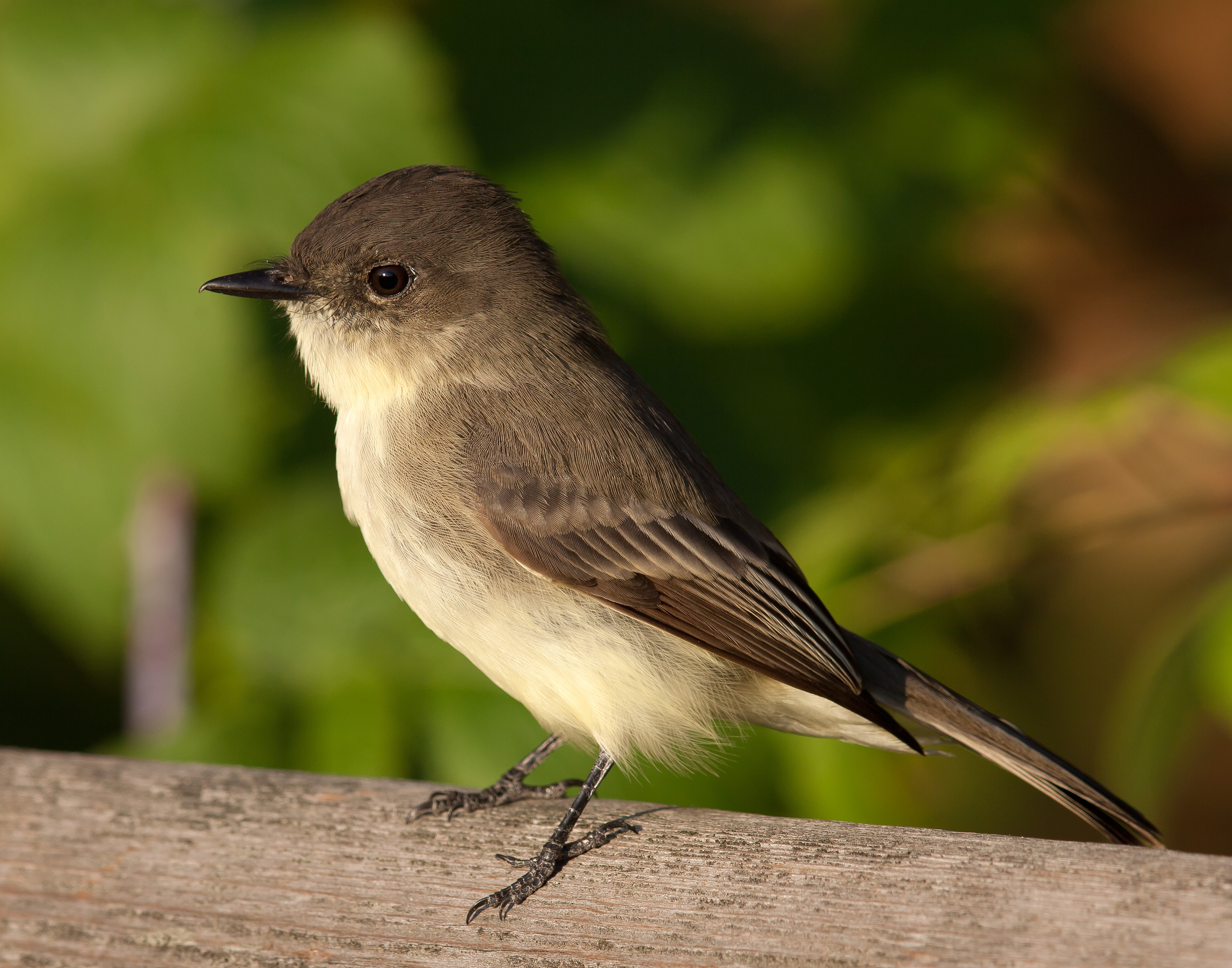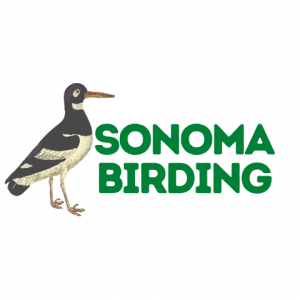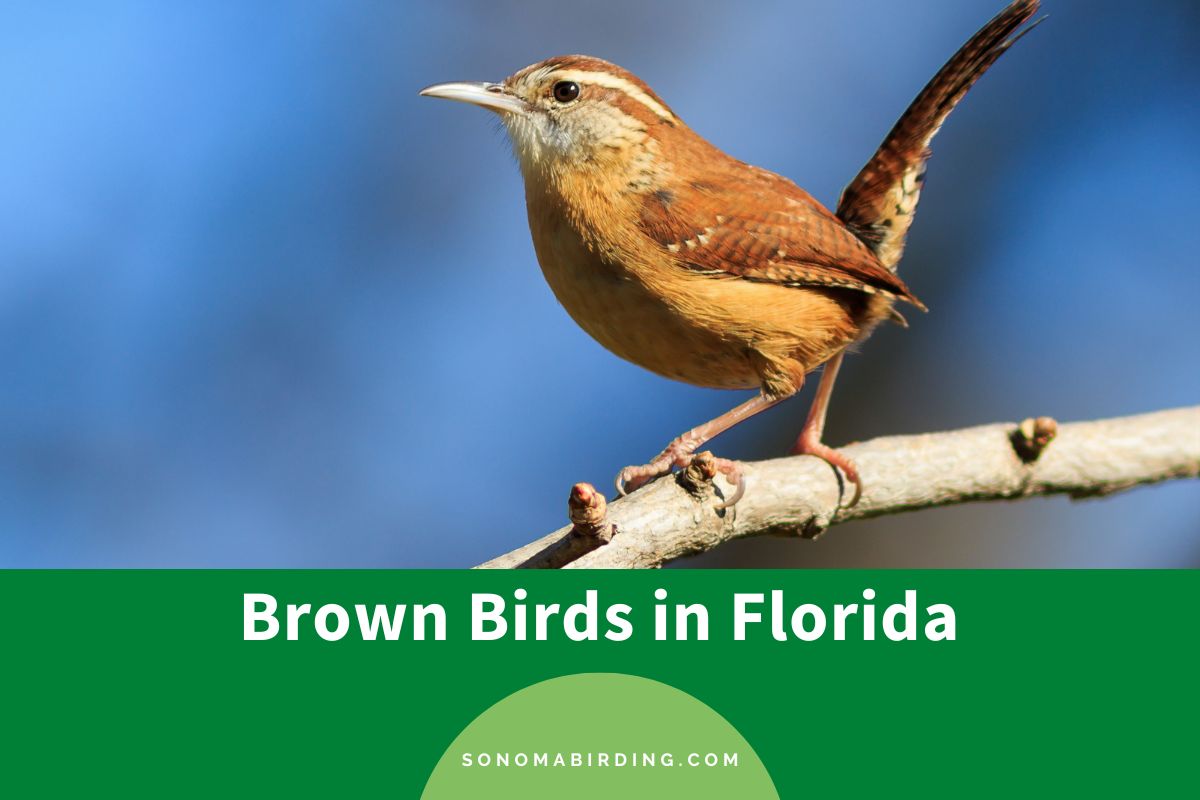Birds of all colors can be found around the world. Some are covered in extravagantly intricate patterns, while others are more plainly plumaged. Regardless of how they look, their designs are typically the result of either natural or sexual selection. In this article, we’ll be taking a close look at several brown birds that can be found in Florida.
1. Northern Cardinal (Female)

| Scientific Name | Cardinalis cardinalis |
| Range | Southern Canada, Midwestern and Eastern United States, Mexico |
The northern cardinal is a backyard bird that you’d typically associate with the bright red plumage found on males. Females, however, are of brown plumage with somewhat red wings and tails. They also consist of a crest, a large red bill, and a long tail.
Typical habitats for the northern cardinal include woodland edges, thickets, suburban gardens, towns, forest clearings, and desert washes. They can also be found in urban areas, such as city parks and backyard feeders.
The northern cardinal’s diet consists of a variety of foods, such as insects (beetles, grasshoppers, caterpillars, ants, flies, etc.), spiders, centipedes, and snails. They also consume a wide array of vegetable matter, such as seeds of weeds and grasses, waste grain, berries, fruits, and flowers.
2. Mourning Dove

| Scientific Name | Zenaida macroura |
| Range | Southern Canada, United States, Central America |
The mourning dove is a slender bird with plain brown plumage, dark-spotted wings, and a long-pointed tail. Juveniles have a scaly pattern yet are larger and have longer tails than ground doves.
Preferred habitats for the mourning dove include agricultural fields, lightly wooded areas, forest edges, and suburban areas. They can often be found sitting on telephone wires or visiting backyard bird feeders.
Mourning doves are granivorous in that they consume mainly seeds, waste grain, and fruit. 99% of their diet is comprised of seeds, especially those from cultivated grains, grasses, ragweed, and other similar plants.
3. Carolina Wren

| Scientific Name | Thryothorus ludovicianus |
| Range | Midwestern and Eastern United States, occasionally in southern Canada and Mexico |
The Carolina wren consists of bright brown plumage above and rusty orange plumage below. They have bold white eyebrows, a slightly curved bill, and a long tail that is nearly as long as their body and is usually cocked up.
Carolina wrens can often be found in dense vegetation, tangled understory, and brush piles in forests. They may nest in specific places in urban areas, such as being tucked in a drainpipe or grill. They will also occasionally visit feeders for suet or mealworms.
The Carolina wren feeds primarily on insects, such as caterpillars, beetles, true bugs, grasshoppers, and crickets. They may also feed on spiders, millipedes, and snails. Occasionally, they’ll catch something as large as small lizards or tree frogs, and they may change their diet to contain more berries, seeds, and fruits during the winter.
4. Eastern Phoebe

| Scientific Name | Sayornis phoebe |
| Range | Canada, United States, Mexico |
The eastern phoebe is a dull-looking, medium-sized flycatcher consisting of brown plumage above and pale coloration below, along with a light-yellow wash on the body. They wag their tails constantly and have duller colored wingbars compared to Empidonax flycatchers.
Typical habitats for the eastern phoebe include open habitats such as woodland edges, brushy fields, and pond edges, where they can often be found alone or in pairs. They may also be found in urban areas, such as under building crevices and other man-made structures.
The diet for the eastern phoebe usually consists of insects, such as small wasps, bees, beetles, true bugs, flies, grasshoppers, and berries. They may also occasionally consume the spider, tick, or millipede. Insects make up the majority of their summer diet.
5. Common Yellowthroat
| Scientific Name | Geothlypis trichas |
| Range | Canada, United States, Central America |
The common yellowthroat is a small warbler consisting of dull brown plumage overall with a bright yellow throat and short, rounded wings. Adult males have black masks that are bordered above by white bands. Females and juveniles are of a duller coloration, but all share contrasting yellow throats and undertail coverts.
Usual habitats for the common yellowthroat include shrubby wet areas such as marshes, forest edges, and fields. They typically hide in thick vegetation, but males will perch up when singing.
Common yellowthroats mainly feed on insects, such as grasshoppers, dragonflies, damselflies, mayflies, beetles, caterpillars, flies, moths, and ants, among others. They may also eat the occasional spider or a few seeds.
6. Great Crested Flycatcher
| Scientific Name | Myiarchus crinitus |
| Range | Midwestern and Eastern United States, Southern Canada, Central America, Venezuela, Colombia |
The great crested flycatcher is a large flycatcher that consists of brown plumage above, a bright yellow belly, a grayish throat and breast, and pink on the lower mandible. They may appear similar to the brown-crested flycatcher.
The great crested flycatcher breeds in deciduous forests and spends most of its time in mature forests. They tend to prefer dense, leafy forests, where they often live in the canopy of tall trees.
The great crested flycatcher feeds mainly on insects, such as caterpillars, moths, butterflies, beetles, and true bugs, among others. They may also eat the occasional spider or small lizard, as well as fruits and seeds. Fruits and seeds become a major part of their diet during the winter in the tropics.
7. Brown Thrasher

| Scientific Name | Toxostoma rufum |
| Range | Canada, United States, Occasionally in Northern Mexico |
The brown thrasher is a bird with reddish-brown plumage upperparts, dark streaking on white underparts, yellow eyes, and a long tail. The tail is longer and somewhat larger than a robin’s tail.
The brown thrasher often hides in thick vegetation in scrubby fields or forest edges, waiting for prey. Other common habitats include thickets, brush, and suburban neighborhoods. They breed typically in dense low-growth areas, such as around the edges of deciduous or mixed woods, swamp edges, or undergrowth in open pine woods.
The diet of the brown thrasher varies quite a bit in that they consume a range of insects, berries, and nuts. Over half of their diet consists of insects, such as caterpillars, grasshoppers, cicadas, and true bugs. They will also consume worms, snails, amphibians, and spiders if they come across them.
8. Eastern Towhee
| Scientific Name | Pipilo erythrophthalmus |
| Range | Midwestern and Eastern United States, Southern Canada |
The eastern towhee is a large sparrow consisting of black upperparts with bright reddish-brown sides, a white belly, and a long tail with white corners. The eye color varies from white (in the southeastern United States) to dark red (in the northern United States, and southern Canada). Females are browner than their jet-black male counterparts.
Typical habitats for the eastern towhee include scrubby areas and forest edges with thickets. Others include woodlands and fields. They are also known to visit bird feeders.
The eastern towhee has quite a range in its diet, including insects, spiders, snails, millipedes, salamanders, lizards, snakes, seeds, berries, and fruits. Typical insects include beetles, caterpillars, moths, and ants, among others.
9. House Wren
| Scientific Name | Troglodytes aedon |
| Range | North, Central, and South America, with the exception of Alaska |
The house wren is a small bird consisting of plain brown plumage overall, slightly paler brown underparts, and some dark streaks on the wings and tail. They lack white eyebrows.
Preferred habitats for the house wren include brushy tangles, thickets, hedgerows, rural farmland, and suburban environments such as parks. They can be found in many open areas containing thick tangles. You can find them perched on top of a bush or fence post, singing their songs during the breeding season.
The house wren’s diet consists mainly of insects, such as beetles, true bugs, grasshoppers, crickets, caterpillars, moths, flies, and among others. They also consume spiders, millipedes, and snails.
10. American Robin

| Scientific Name | Turdus migratorius |
| Range | North America, Mexico |
The American robin is a large songbird consisting of a round body, long legs, a black head, and a fairly long tail. They are gray above and reddish brown below. They are often found with their bills tilted upward.
The American robin is typically found in trees during fall and winter, where they gather to roost or eat berries. Other common habitats where you may find them include gardens, parks, yards, golf courses, fields, pastures, and many other wooded areas.
The American robin consumes mainly insects, berries, and earthworms. Insects, as well as earthworms, snails, spiders, and other invertebrates, make up the majority of the American robin’s diet during the summer. This then changes to fruit and wild berries during the winter.
11. House Finch (Female)
| Scientific Name | Haemorhous mexicanus |
| Range | United States, Southern and Central Canada, Mexico |
The house finch is a bird that appears quite differently for males and females. Though males vary in shades and intensity of red and can appear yellow or orange, females are always of a dull gray-brown coloration, along with plain faces and streaked underparts. Compared to males, females lack the boldface pattern and have subtler patterning in general.
Typical habitats for the house finch include open woods, brushy field edges, deserts, and urban environments such as neighborhoods and backyard feeders.
Seeds, buds, and berries make up the majority of the house finch’s diet. Their diet is almost entirely comprised of vegetable matter such as weed seeds. They consume mainly buds and other flower parts during spring and berries and small fruits during late summer and fall.
12. House Sparrow

| Scientific Name | Passer domesticus |
| Range | North America, Central America, South America, Africa, Australia, New Zealand, Central Asia, Middle East, India, Europe |
The house sparrow is a small bird that, for males, consists of black bibs, reddish-brown napes, and wings patterned with buffs and browns, and, for females, consists of plain brown plumage and light-colored eyebrows. Males and females both have pale gray underparts.
The house sparrow is common in urban areas, such as cities, suburbs, and neighborhoods, as well as near any location that may contain manmade structures, such as in deserts and forests. They are never found in unaltered natural habitats.
The house sparrow’s diet consists mainly of grains and seeds, as well as discarded food and insects. Some of the crops they consume include corn, oats, and wheat. They will eat various types of bird seed and will cheerfully collect leavings at outdoor dining areas.
13. American Goldfinch

| Scientific Name | Spinus tristis |
| Range | United States, Southern, and Central Canada, and Occasionally in northern Mexico |
The American goldfinch is a small finch with a sharp bill, which changes from pink in the summer to grayish-brown in the winter, small head, long wings, and a short-notched tail. Adult males are bright yellow in the spring and summer and brown in the winter. Females are of a dull yellow color, which also turns to brown during the winter.
Common habitats for the American goldfinch include weedy fields, cultivated areas, roadsides, orchards, and backyards, where they are known to visit bird feeders.
Seeds, especially those from the daisy family and those of weeds and grasses, make up the majority of the American goldfinch’s diet. They also consume the seeds of elm, birch, and alder trees. They occasionally feed on insects during the summer.
14. Brown-Headed Cowbird
| Scientific Name | Molothrus ater |
| Range | North America, Mexico |
The brown-headed cowbird is a small bird with a stout bill, a short tail, and a plump body. Males are of glossy black color with a light brown head. Females are gray-brown throughout, without any streaks, but with a paler throat. Juveniles have brown streaks.
The brown-headed cowbird can typically be found in habitats such as open woods, farmland, and stockyards. Other habitats include grasslands with scattered trees, woodland edges, brushy thickets, prairies, fields, pastures, orchards, and urban residential areas.
The brown-headed cowbird’s diet consists mainly of seeds and insects. Seeds typically come from grasses, weeds, and waste grains. Insects may include grasshoppers, beetles, and caterpillars, among others. They may consume spiders and millipedes on occasion.
15. Northern Flicker

| Scientific Name | Colaptes auratus |
| Range | North and Central America |
The northern flicker is a large woodpecker consisting of brown plumage, black barring on the back, black spots on the belly, a bright white rump, and a large black crescent-shaped mark on the breast. The wings and tail can either appear yellow or red, depending on the subspecies.
Typical habitats for the northern flicker include woodlands, forest edges, and open fields with scattered trees. They may also visit urban areas such as city parks and suburbs. Toward the west, they may inhabit different types of forest, including burned forests.
The diet of the northern flicker usually includes insects, such as ants and beetles, which they pick up from the ground. They also consume seeds and fruits during the winter. They typically hammer at the soil in order to reach the ants underground.
16. Chipping Sparrow

| Scientific Name | Spizella passerina |
| Range | North and Central America |
The chipping sparrow is a small, slender sparrow with a gray breast, a reddish-brown cap, and black eyelines during the breeding season. They are not as bright during the winter but will still show a brown cap and dark eyelines. Juveniles have many streaks across their body.
Typical habitats for the chipping sparrow include open woodlands, scrubby areas, and some suburban settings. They are known to visit bird feeders.
The chipping sparrow’s diet usually consists of insects and seeds, though their specific diet can vary with the season. They feed mainly on insects, such as grasshoppers, caterpillars, beetles, and true bugs, during the summer. This then changes to seeds, such as those from grasses, weeds, and waste grain, during fall and winter.
17. Savannah Sparrow

| Scientific Name | Passerculus sandwichensis |
| Range | North and Central America |
The savannah sparrow is a medium-sized sparrow consisting of a short tail, streaks across the body, and yellow patches in front of the eyes. There is quite a bit of variation across their range, such that the yellow patches can be absent in some individuals. For example, those in California and Baja have larger bills and gray streaks, while others may have dark and bold streaks.
The savannah sparrow is found in open areas, such as meadows, hayfields, tundra, coastal dunes, and grasslands. They tend to hide in thick thatches of a prior season’s dead grasses.
The savannah sparrow’s diet consists mainly of insects and seeds. They will consume insects and spiders during the breeding season, as those can provide them with the necessary amount of nutrients and protein. This then changes to seeds from grasses and forbs during the winter.
18. Cedar Waxwing
| Scientific Name | Bombycilla cedrorum |
| Range | North and Central America |
The cedar waxwing is a plump bird with light brown plumage, a sleek crest, a black mask, a light yellow wash on the belly, and a yellow-tipped tail. Juveniles are of a duller plumage than adults, with streaks on the breast as well as a reduced mask.
Typical habitats for the cedar waxwing include open woodlands, orchards, shrubby areas, forest edges, streamsides, overgrown fields, swamp edges, and suburban yards. Most of their habitats depend on the availability of fruiting trees and shrubs.
The cedar waxwing’s diet mainly comprises berries and insects. They feed on berries, such as those from juniper and dogwood, and fruit, such as wild cherries, throughout much of the year. They eat more insects, such as beetles, caterpillars, and ants, during the summer.
19. Swamp Sparrow
| Scientific Name | Melospiza georgiana |
| Range | North America, Mexico |
The swamp sparrow is a medium-sized sparrow consisting of reddish-brown and gray patterned plumage, reddish-brown wings, and plain underparts. Adults are gray below with buffy sides, with males having a reddish-brown crown. Juveniles show more buffy tones on the face and streaks on the underside.
Typical habitats for the swamp sparrow include cattail marshes and their namesake swamps. In the winter, they may also be present in brushy habitats that are either wet or close to water. They rarely visit bird feeders.
The swamp sparrow’s diet consists mainly of insects, such as ants, bees, wasps, beetles, aphids, and caterpillars, as well as aquatic invertebrates, such as damselflies and dragonflies. They also consume the occasional blueberry and the seeds of sedges and grasses.
20. Northern Waterthrush

| Scientific Name | Parkesia noveboracensis |
| Range | North and Central America, Colombia, Venezuela |
The northern waterthrush is a brown-and-white bird that consists of white underparts with a yellow wash and dark streaks, whitish eyebrows, streaks on the throat, and dull legs.
The northern waterthrush usually prefers habitats containing thickets, dense bogs, or alder swales around bodies of water. They tend to nest along streams that contain brushy or shrubby borders.
The northern waterthrush eats mainly larval and adult insects, such as stoneflies, mayflies, ants, and weevils. Other prey includes spiders, snails, clams, fish, and salamanders.
Conclusion
Where it lacks in cool weather, Florida makes it up by having a large variety of brown birds. Though these birds share the characteristic brown plumage, they also each have their own unique traits and appearances that make them unique. Be sure to take your binoculars with you, and you’re sure to come across some of these birds the next time you head out.
Related articles:
15 Black Birds with White Spots









